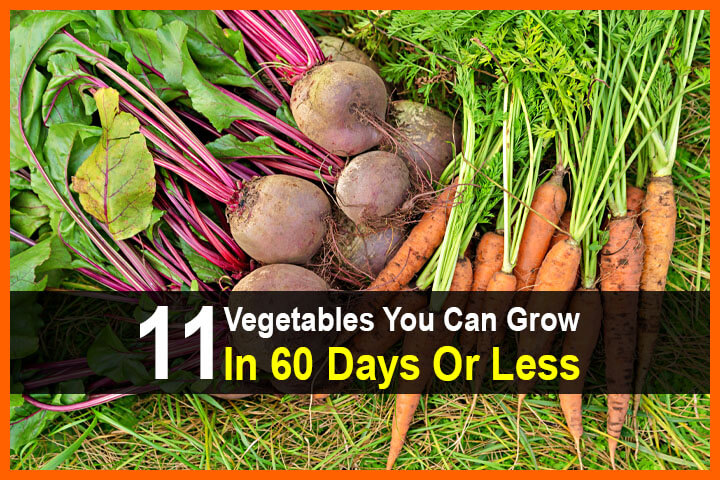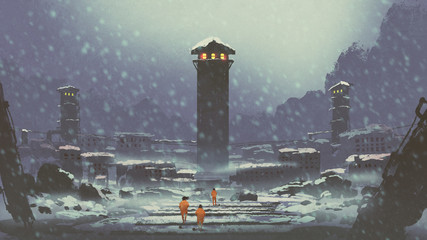Estimated reading time: 11 minutes
In 1607,the first settlers of Jamestown Virginia were beset by a series of problems that left them isolated and without food for months. Supplies from England did not arrive, crops failed, and trade with the Powhatan did not yield enough food. This period would be known by history as The Starving Time. Conditions were so brutal that they lost about 440 people by spring, of a party that totaled only 500.
What most preppers and survivalists get wrong about preparing for winter is that you aren’t really preparing for one season. You are preparing for two, winter and the beginning of spring. There is no reason to assume the frost will recede enough to grow and you are also going to face a period between when those seeds go in the ground and when they are productive.
So, to avoid your own version of The Starving Time, what kinds of vegetables can you plant that will be ready to harvest in 60 days or less?
Want to save this post for later? Click Here to Pin It On Pinterest!
20-30 DAYS TILL HARVEST
1. Radishes

Radishes are always the first seeds I plant. It’s not because I hope to have a massive harvest and eat only radishes and radish tops in my own starving time. I just really like them. They have that great crisp bite and that nice radish burn.
To me radishes signify the beginning of the growing season, and you can munch a fresh radish in less than a month! If you like to rush into spring this is a great vegetable for that.
- Plant in cool seasons; radishes prefer temperatures between 50-65°F.
- Sunlight: Requires full sun but can tolerate partial shade.
- Soil: Well-drained soil, rich in organic matter.
- Planting Time: Early spring or fall; can tolerate light frost.
- Spacing: Plant seeds 1/2 inch deep, 1-2 inches apart in rows spaced 12-18 inches.
2. Green Onions

Green onions are not the kind of vegetable that you salivate over very much but they are a fast growing spring vegetable that can add green to the garden and fresh flavor to your food in less than 30 days.
- Grow in cool to mild temperatures; adaptable but prefer around 60-70°F.
- Sunlight: Prefer full sun but can tolerate partial shade.
- Soil: Well-drained, fertile soil with a slightly acidic to neutral pH.
- Planting Time: Early spring or late summer for fall harvest.
- Spacing: Plant seeds or sets 1 inch apart in rows spaced 12-18 inches.
- Depth of Planting: Plant seeds 1/4 to 1/2 inch deep.
- Watering: Keep soil consistently moist, especially during dry periods.
30-40 DAYS TILL HARVEST
3. Lettuce

Soon after those radishes pop out of the ground you can have early season lettuce in hand, too. Some of the best early season lettuces to grow are Buttercrunch and Crispino Iceberg. These lettuces grow fast in the cold weather and shorter spring days.
Of course, the trouble with early lettuce is having no fresh tomatoes to toss in your salad along with the radish. Instead, you can add things like fresh mint and asparagus.
- Prefers cool weather; best in temperatures between 45-75°F.
- Sunlight: Partial shade to full sun; some varieties tolerate more shade.
- Soil: Well-drained, fertile soil with a slightly acidic to neutral pH.
- Planting Time: Early spring or late summer for fall harvest; can withstand light frost.
- Spacing: Plant seeds 1/8 to 1/4 inch deep, 6-12 inches apart in rows spaced 12-18 inches.
4. Spinach

In the restaurant industry it is very common to cut more expensive spring mix and heirloom lettuces with baby spinach. This rapidly growing vegetable is ideal for the spring. It is a leafy green that can be eaten raw or cooked.
- Prefers cool weather; grows well in temperatures between 40-75°F.
- Sunlight: Thrives in partial shade but can tolerate full sun.
- Soil: Well-drained, nutrient-rich soil with a slightly acidic to neutral pH.
- Planting Time: Early spring or late summer for fall harvest; can withstand light frost.
- Spacing: Plant seeds 1/2 to 1 inch deep, 2-4 inches apart in rows spaced 12-18 inches.
5. Arugula

The peppery bite of arugula is truly the taste of spring. When the soft round baby arugula is sprouting there is nothing better to snack on or add to salads. Arugula deserves a nice big bed to grow in or even a hydroponics setup inside your home. Keep it close by!
- Thrives in cool weather; best in temperatures between 50-70°F.
- Sunlight: Prefers partial shade but can tolerate full sun.
- Soil: Well-drained, fertile soil with a slightly acidic to neutral pH.
- Planting Time: Spring or fall; grows quickly and bolts in hot weather.
- Spacing: Plant seeds 1/4 to 1/2 inch deep, 2 inches apart in rows spaced 12-18 inches.
40 – 60 DAYS TILL HARVEST
6. Bush Beans

This amazing little plant can often be overshadowed by its climbing counterpart, the pole bean. That said, bush beans produce a lot of food in a short period of time. You can plant these pretty early in the season and have a great food source for snacking on fresh, cooking, and canning.
- Bacon, onions, and sauteed bush beans are a side dish that almost no one can turn down.
- Plant after the last frost when soil temperature is 70-80°F.
- Sunlight: Requires 6-8 hours of full sun daily.
- Soil: Well-drained, slightly acidic to neutral (pH 6.0-7.0).
- Planting Time: Spring, after last frost.
- Spacing: 4-6 inches apart in rows spaced 18-24 inches.
7. Baby Carrots

Carrots can grow very rapidly, in fact, they can even be planted the year before! They will begin to grow when the threat of frost is gone. If you don’t wait till maturity, then you can have carrots much quicker by harvesting those little baby carrots.
You can also plant a species like Coventry carrots which are designed to stay small and mature quickly.
- Prefers cool weather; best in temperatures between 45-75°F.
- Sunlight: Partial shade to full sun; some varieties tolerate more shade.
- Soil: Well-drained, fertile soil with a slightly acidic to neutral pH.
- Planting Time: Early spring or late summer for fall harvest; can withstand light frost.
- Spacing: Plant seeds 1/8 to 1/4 inch deep, 6-12 inches apart in rows spaced 12-18 inches.
8. Kale

The nutritional powerhouse that was once nothing more than a plate garnish in restaurants, has become a staple in my garden. My children have been ripping kale leaves and munching them raw since they were big enough to walk.
Kale is such a quick growing plant that you can even grow it several times per year. In the earliest parts of spring and in the latter part of the growing seasons into winter.
- Thrives in cool weather; grows well in temperatures between 45-75°F.
- Sunlight: Full sun to partial shade; can tolerate light shade.
- Soil: Well-drained, fertile soil with a slightly acidic to neutral pH.
- Planting Time: Spring or fall; can tolerate light frost.
- Spacing: Plant seeds 1/4 to 1/2 inch deep, 12-18 inches apart in rows spaced 18-24 inches.
9. Mustard Greens

Another spicy green that is not a favorite in most annual gardens. Still, mustard greens are incredibly nutritious. They are one of my favorites for that reason and because when they are cooked down with a little smoked pork, they can be decadent.
- Thrives in cool weather; grows well in temperatures between 45-75°F.
- Sunlight: Full sun to partial shade; can tolerate light shade.
- Soil: Well-drained, fertile soil with a slightly acidic to neutral pH.
- Planting Time: Spring or fall; can tolerate light frost.
- Spacing: Plant seeds 1/4 to 1/2 inch deep, 6-12 inches apart in rows spaced 18-24 inches.
10. Turnips

Turnips are a rapid growing 2 for 1 deal. You see most people enjoy the turnip bulb. Roasted turnips can be eaten alone or tossed with other root vegetables and all of them roasted together. Of course, the turnip bulbs are only part of the prize.
You also get the greens, and those incredible greens are another to add to the list of leafy greens that are packed with nutrition.
You can cook down the greens in bacon grease and add small, diced turnips to the mix to eat the whole plant.
- Cool-season crop; grows well in temperatures between 50-75°F.
- Sunlight: Full sun to partial shade; can tolerate light shade.
- Soil: Well-drained, loose soil with a slightly acidic to neutral pH.
- Planting Time: Early spring or late summer for fall harvest; can tolerate light frost.
- Spacing: Plant seeds 1/4 to 1/2 inch deep, 2-4 inches apart in rows spaced 12-18 inches.
11. Swiss Chard

The multicolored ribs of Swiss chard make it a beautiful plant to have in your garden. It is the most off putting of the leafy greens, in my opinion. While Swiss chard does have a nutrient dense profile, it needs a lot of garlic or some other seasonings.
- Cool-season crop; grows well in temperatures between 50-75°F.
- Sunlight: Full sun to partial shade; can tolerate light shade.
- Soil: Well-drained, fertile soil with a slightly acidic to neutral pH.
- Planting Time: Spring or fall; can tolerate light frost.
- Spacing: Plant seeds 1/2 to 1 inch deep, 6-12 inches apart in rows spaced 18-24 inches.
Conclusion
The WEF, the creators of The Great Reset, would like to reimagine the food system from seed to fork. I don’t know about you but to me that sounds terrifying! However, I think we should follow their lead.
Now is the time for US to reimagine our own personal food system from seed to fork. Our gardens, our livestock, our local farmers, are all the key to this. The year is 2024 and we should not be worrying about the starving time. Grow more this year than ever before.
Get your gardens started early and grow some of these incredible vegetables that take 60 days or less to harvest.
Like this post? Don’t Forget to Pin It On Pinterest!

Read the full article here




